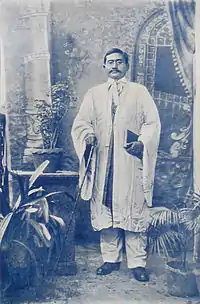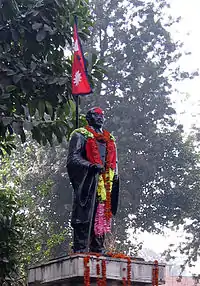


Shukra Raj Shastri (Nepali: शुक्रराज शास्त्री) (born Shukra Raj Joshi) (1894–24 January 1941) was a Nepalese intellectual and fighter for democracy who was executed by the autocratic Rana dynasty. He is one of the four martyrs of the Nepalese revolution that toppled the Rana regime. The other three are Dashrath Chand, Dharma Bhakta Mathema and Ganga Lal Shrestha.[1][2][3]
Shastri was also a social reformer and author who wrote a number of books in Nepali and Nepal Bhasa.[4]
Early life
Shastri was born in Varanasi, India where his father Madhav Raj and mother Ratna Maya Joshi were living in forced exile due to political reasons. Madhav Raj was a leader of the Arya Samaj in Nepal. The Joshis were originally from Lalitpur.[5]
Shukra Raj was schooled in India, and he acquired the title Shastri after earning a Shastri degree from Dehradun. He became better known by this name than his actual surname Joshi.
Democracy fighter
Returning to Nepal, Shastri joined the democracy struggle. During a demonstration organized at Indra Chok, Kathmandu by the Citizens' Rights Committee, he spoke out strongly against the Rana regime and demanded the people's rights. For this act, he was arrested and sentenced to six years' imprisonment. He was subsequently sentenced to death, and on 24 January 1941, he was hanged from a tree on the side of the road at Pachali, Teku, Kathmandu.[6]
The Ranas were eventually overthrown in February 1951, and democracy was established in Nepal.[7] The Rana oligarchy ruled Nepal from 1846 until 1951. During this time, the Shah king was reduced to a figurehead and the prime minister and other government positions were hereditary. Jang Bahadur Rana established the Rana dynasty in 1846 by masterminding the Kot massacre in which about 40 members of the nobility including the prime minister and a relative of the king were murdered. Tyranny, debauchery, economic exploitation and religious persecution characterized Rana rule. This 104-years of Rana regime has been called as one of the darkest periods of Nepalese history.[8][9]
Writer
Shastri was one of the leaders of the Nepal Bhasa renaissance.[10] He wrote a grammar of the language entitled Nepal Bhasa Vyakaran which was published from Kolkata in 1928. He was the first to produce children's literature. His other works include Nepal Bhasa Reader, Books 1 and 2 (1933) and Nepali Varnamala (1933).[11][12]
It is believed that Shastri was executed more for his work in social reform and efforts to develop his mother tongue Nepal Bhasa than his involvement in politics. Shastri did not belong to any political party unlike the other three martyrs who were members of Nepal Praja Parishad.[13][14]
Legacy
Shastri and the other martyrs are honoured on Martyrs Day which is observed annually on Magh 16 (29 or 30 January) across the country.[15] Shukra Path, a street in downtown Kathmandu, is named after him.[16] Shastri's statues have been erected at a number of places, and the Postal Service Department has issued commemorative postage stamps depicting his image.[17] A monument known as Shahid Gate containing the busts of the four martyrs and King Tribhuvan was built in central Kathmandu in 1961.[18]
See also
References
- ↑ Whelpton, John (2005). A History of Nepal. Cambridge University Press. ISBN 0-521-80470-1, ISBN 978-0-521-80470-7. Page 80.
- ↑ "Martyrs' Day observed across country". The Kathmandu Post. 30 January 2012. Retrieved 6 February 2012.
- ↑ Joshi, Bhuwan Lal and Rose, Leo E. (1966) Democratic innovations in Nepal: A case study of political acculturation. University of California Press. Page 55.
- ↑ Tuladhar, Prem Shanti (2000). Nepal Bhasa Sahityaya Itihas: The History of Nepalbhasa Literature. Kathmandu: Nepal Bhasa Academy. ISBN 99933-56-00-X. Page 93.
- ↑ Whelpton, John (2005). A History of Nepal. Cambridge University Press. ISBN 0-521-80470-1, ISBN 978-0-521-80470-7. Page 79.
- ↑ "Martyrs' Week celebrations". The Himalayan Times. 25 January 2012. Archived from the original on 2 May 2014. Retrieved 6 February 2012.
- ↑ Kraemer, Karl-Heinz. "The Revolution of 1950/51". Nepal Research. Retrieved 17 August 2013.
- ↑ Dietrich, Angela (1996). "Buddhist Monks and Rana Rulers: A History of Persecution". Buddhist Himalaya: A Journal of Nagarjuna Institute of Exact Methods. Retrieved 3 September 2011.
- ↑ Lal, C. K. (16 February 2001). "The Rana resonance". Nepali Times. Retrieved 17 September 2013.
- ↑ Shrestha, Bal Gopal (January 1999). "The Newars: The Indigenous Population of the Kathmandu Valley in the Modern State of Nepal)" (PDF). CNAS Journal. Retrieved 23 March 2012. Page 87.
- ↑ Bajracharya, Phanindra Ratna (2003). Who's Who in Nepal Bhasha. Kathmandu: Nepal Bhasa Academy. Page 27.
- ↑ थकालिम्ह वैय्याकरण शुक्रराज शास्त्री, Author Dr. Sundar Krishna Joshi, Page 35, Shukraraj Topical Hospital Memorial-2057
- ↑ Shrestha, Siddhicharan (1992). Siddhicharanya Nibandha ("Siddhicharan's Essays"). Kathmandu: Phalcha Pithana.
- ↑ Tumbahang, Govinda Bahadur (January 2010). "Marginalization of indigenous languages of Nepal". Contributions to Nepalese Studies. Retrieved 4 March 2012.
- ↑ "Martyrs' Day observed across country". The Kathmandu Post. 30 January 2012. Retrieved 6 February 2012.
- ↑ "Addressed Road Network Map". Kathmandu Metropolitan City. Archived from the original on 6 October 2011. Retrieved 6 February 2012.
- ↑ "List of Nepali Postage Stamps Issued". Postage Stamps of Nepal. Retrieved 5 September 2013.
- ↑ "Former king's statue to be moved from Shahid Gate to Narayanhiti". The Himalayan Times. 2 January 2012. Retrieved 6 February 2012.